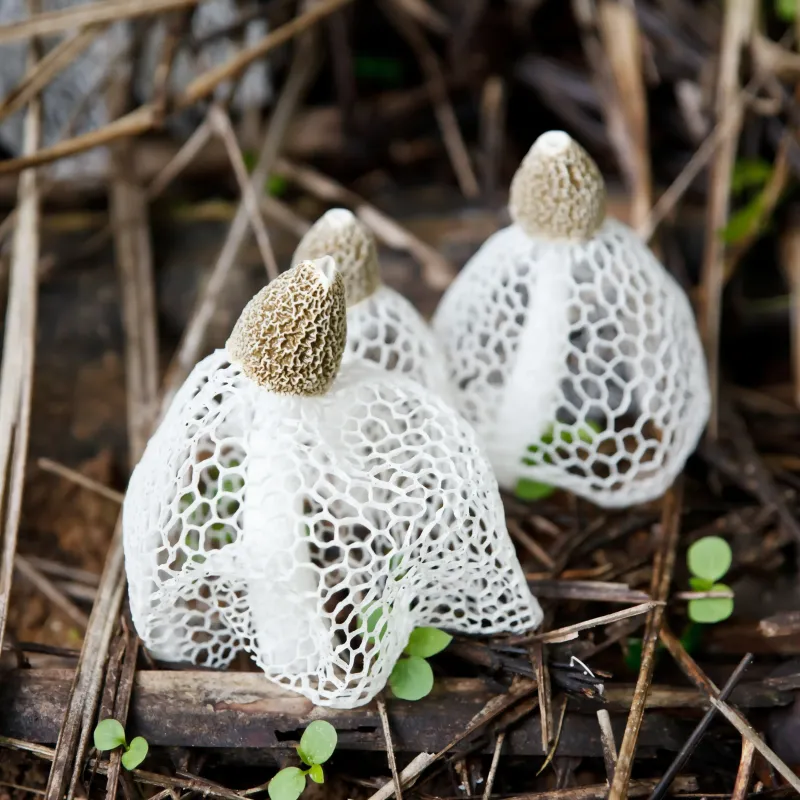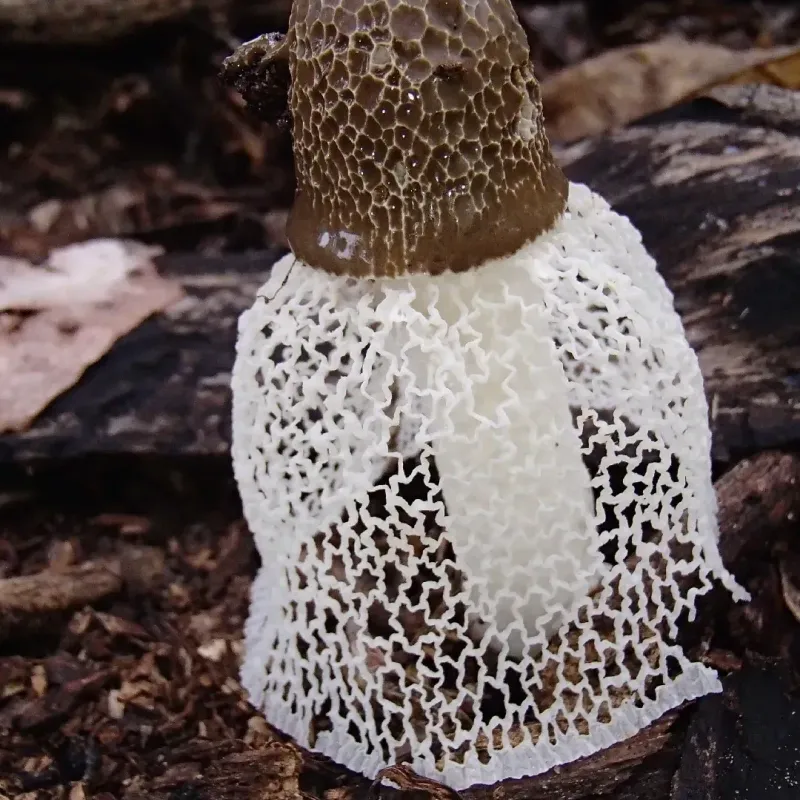
About
Dictyophora indusiata, also known as the Veiled Oyster, Bamboo Mushroom, or Bridal Veil Fungus, is a striking and unusual mushroom belonging to the stinkhorn family. It is prized in Asian cuisine for its texture and flavor, and in traditional medicine for its anti-inflammatory and antioxidant properties. Its lacy white skirt-like structure (indusium) and phallic fruiting body make it instantly recognizable and culturally symbolic.
History
Revered in Chinese traditional medicine and cuisine, D. indusiata has been consumed for centuries as both a delicacy and a tonic mushroom, believed to promote gut health, immunity, and blood circulation. It appears in ancient Chinese texts and is still cultivated today in regions like China, Vietnam, and Thailand, often in bamboo forests.
In culinary use, it's typically dried and rehydrated in soups and stir-fries. It is also known for being nutritious, low in calories, and rich in polysaccharides.
Overview
The fruiting body consists of a white stalk topped with a bell-shaped cap that exudes a foul-smelling slime (gleba) to attract insects for spore dispersal. Hanging from the cap is a beautiful lacy white net or veil (indusium) that gives the fungus its name. The mushroom grows from an egg-like sac and emerges rapidly—sometimes within hours.
Although the cap and gleba are discarded due to the odor, the indusium and stalk are edible and contain bioactive compounds with potential antibacterial, immune-regulating, and antioxidant benefits.
Flavors
Sweet
Subtle sweet taste
Textures
Tender
Soft when cooked, but not mushy
Fibrous
Stringy, fibrous structure
Fragrances
Pleasant
Mild, vaguely floral scent
Floral
Sweet, perfume-like aroma
Physical Characteristics
Caps:
Conical to bell-shaped, 5-15 cm tall. White to yellow-brown with cottony veil.
Gills:
Decurrent, white, crowded.
Helps With
Immune System
Polysaccharides can stimulate immune response
Similar Species

Species: Phallus indusiatus
Edibility: non-edible
Key Differences: Foul odor, lacks veil over cap

Species: Phallus indusiatus
Edibility: non-edible
Nutrition Facts
Mushroom Ratings
0.0
Based on 0 Reviews
5
★4
★3
★2
★1
★Share your thoughts
If you've consumed this mushroom, share your thoughts with our community
References
The relationship between mycelial growth and fruit body’s yield of oyster mushrooms (Pleurotus spp.) collected from southern Vietnam
Chemical Constituents of the Mushroom Dictyophora indusiata and Their Anti-Inflammatory Activities
Identification of the Antidepressant Function of the Edible Mushroom Pleurotus eryngii
Enhanced growth and yield of oyster mushroom by growth-promoting bacteria Glutamicibacter arilaitensis MRC119
Production and partial characterization of the exopolysaccharide from Pleurotus sajor caju
Mushroom-based cosmeceutical ingredients: Microencapsulation and in vitro release profile
Antioxidant, antitumor and immunostimulatory activities of the polypeptide from Pleurotus eryngii mycelium
Investigation of Lovastatin, the Anti-hypercholesterolemia Drug Molecule from Three Oyster Mushroom Species
Regulation of primary metabolic pathways in oyster mushroom mycelia induced by blue light stimulation: Accumulation of shikimic acid
Antimicrobial Activity of Mycelia of Oyster Mushroom Species (Pleurotus spp.) and Their Liquid Filtrates (In Vitro)
Pleurotus spp. is one of the most important cultivated mushrooms in the world. The relationship between mycelial growth and production yield of Pleurotus strains collected from southern Viet Nam was determined.Total 10 of both wild and cultivated strains including 6 phoenix and 4 oyster strains were used in this study. The mycelial growth rate was conducted by 4 models such as the acreage of mycelial colonies on potato dextrose agar, the dried weight of mycelia in potato dextrose broth, the area of mycelial colonies on sawdust plates and the depth of mycelial colonies on sawdust testubes. The volume of mycelial colonies was estimated based on the area of mycelial colonies and their depth on sawdust plates.
2023
As an edible and medicinal fungus, Dictyophora indusiata is well-known for its morphological elegance, distinctive taste, high nutritional value, and therapeutic properties. In this study, eighteen compounds (1–18) were isolated and identified from the ethanolic extract of D. indusiata
2023
Pleurotus eryngii produces various functional molecules that mediate physiological functions in humans. Recently, we observed that P. eryngii produces molecules that have antidepressant functions. An ethanol extract of the fruiting body of P. eryngii was obtained, and the extract was purified by XAD-16 resin using an open column system. The ethanol eluate was separated by HPLC, and the fraction with an antidepressant function was identified.
2021
Promotion of mushroom growth by means of biological agents replacing chemicals is an emerging and highly demanded issue in the sector of mushroom cropping. The present study was aimed to search for a novel bacterium potentially able to enhance mushroom growth and yield. A total of 2165 bacterial isolates purified from different samples were scrutinized through various growth-promoting attributes.
2021
Microbial exopolysaccharides (EPSs) are very important because they are used in biotechnological applications in different industrial areas. The aim of the study was to determine the best EPS producer Pleurotus sp., to optimize EPS production and to perform partial purification and characterization of the produced EPS.
2019
Mushrooms can be used as a source of cosmeceutical ingredients. Agaricus bisporus and Pleurotus ostreatus ethanolic extracts present important bioactive properties, but with some compounds showing easy oxidation and degradation. In the present work, microencapsulation by atomization/coagulation technique was used to protect the extracts. The obtained microspheres were characterised in terms of morphology, particle size distribution and encapsulation efficiency.
2018
The objective of this study was to investigate the antioxidant, antitumor and immunological activities of the polypeptide from Pleurotus eryngii mycelium (PEMP). The ability of the polypeptide to stimulate Ana-1 macrophages to englobe neutral red, secrete NO, H2O2, TNF-alpha, and IL-6, increase TLR2 and TLR4 expression levels and Ana-1 cell survival rate were investigated to study its immunocompetence.
2017
Research on the availability of lovastatin in different mushroom species, mechanism of control of diseases like hypercholesterolemia and their drug efficacy are limited. Therefore, the present investigation is focused on quantitative and qualitative analysis of lovastatin from different highly preferred edible oyster mushrooms species by the consumers. The study was carried out for the determination of lovastatin content from different species of mushroom like, Pleurotus ostreatus (grey), Hypsizygus ulmarius (white) and Agaricus djamor (pink) under different culture conditions like Solid State Fermentation (SSF), Submerged Fermentation (SMF) and in the powder of dried mushroom of P. ostreatus as well.
2017
Shikimic acid is a key intermediate in the aromatic amino acid pathway as well as an important starting material for the synthesis of Tamiflu, a potent and selective inhibitor of the neuraminidase enzyme of influenza viruses A and B. Here we report that in oyster mushroom (Pleurotus ostreatus) mycelia cultivated in the dark, stimulation with blue light-emitting diodes induces the accumulation of shikimic acid.
2015
In vitro, antimicrobial activity of four species of oyster mushrooms: Pleurotus ostreatus (grey and white strains), Pleurotus cornucopiae (bright yellow strain) and Pleurotus salmoneostramineus (pink stain) in form filtrates and mycelia were investigated against five standard strains of pathogenic bacteria and yeast. The filtrate of P. salmoneostramineus was best one compared with other filtrates against Pseudomonas aeruginosa ATCC 27853 and Candida parapsilosis ATCC 22019 respectively.
2015